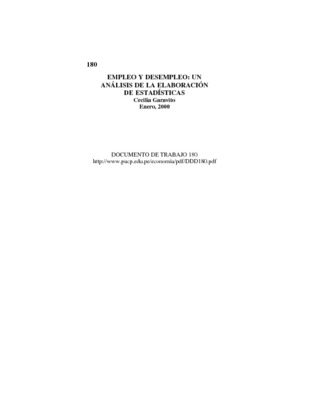| dc.contributor.author | Garavito, Cecilia | |
| dc.date.accessioned | 2015-03-19T20:37:39Z | |
| dc.date.available | 2015-03-19T20:37:39Z | |
| dc.date.issued | 2000 | |
| dc.identifier.uri | http://repositorio.pucp.edu.pe/index/handle/123456789/46820 | |
| dc.description.abstract | Las series de empleo y desempleo son piezas fundamentales para el análisis de los efectos de la política económica sobre el bienestar de los hogares. La divergencia entre lo que la opinión pública percibe como un problema de falta de empleo y lo que el gobierno afirma, que el problema es solamente uno de bajos ingresos, hace necesario revisar dichas series. Dos son los cuestionamientos hechos con respecto a la calidad de las series de empleo y desempleo en nuestro país. En primer lugar, el crecimiento casi continuo del empleo medido por la serie obtenida a partir de la Encuesta Nacional de Hogares (ENAHO), frente a la caída del empleo en el sector moderno, medido por las series obtenidas a partir de la Encuesta de Variación del Empleo (EVE). Razones que podrían estar explicando esta divergencia en alguna medida son: diferencias en el universo de las fuentes empleadas, fallas en el registro del empleo temporal y cambios en los cuestionarios de las encuestas, en la cobertura y en el diseño muestral. En segundo lugar, la poca variación de la tasa de desempleo abierto y su bajo nivel, la cual estaría explicada por sesgos en la elaboración de la ENAHO, por la manera de medir el indicador, y por el problema aún no resuelto del desempleo oculto. | es_ES |
| dc.description.abstract | The series of employment and unemployment are fundamental pieces for the analysis of the effects of the economic policy on the well being of households. The divergence between which the public perceives like a problem of lack of employment and what the government affirms, that the problem is only one of low income, makes it necessary to review these series. Two are the problems mentioned on the quality of the series in our country. In the first place, the almost continuous growth of employment as measured by the series obtained from the National Survey of Households (NSH), as opposed to the descend of the employment in the modern sector, measured by the series obtained from the Survey of Variation of Employment (SVE). Reasons that could be explaining this divergence to a certain extent are: differences in the universes of the sources used, faults in the registration of temporary employment and changes in the questionnaires of the surveys, the sample cover and its design. Secondly, the little variation of the rate of open unemployment and its low level, which would be explained by slants in the processing of the NSH, by the way to measure the indicator, and by the problem not yet solved of hidden unemployment. | en_US |
| dc.language.iso | spa | es_ES |
| dc.publisher | Pontificia Universidad Católica del Perú. Centro de Investigaciones Sociológicas, Económicas, Políticas y Antropológicas - CISEPA | es_ES |
| dc.relation.ispartofseries | Documento de Trabajo;180 | es_ES |
| dc.rights | info:eu-repo/semantics/openAccess | es_ES |
| dc.rights.uri | http://creativecommons.org/licenses/by-nc-nd/2.5/pe/ | * |
| dc.subject | Desempleo--Perú | es_ES |
| dc.subject | Empleos--Perú | es_ES |
| dc.title | Empleo y desempleo: un análisis de la elaboración de estadísticas | es_ES |
| dc.title.alternative | Employment and unemployment: An analysis of how statistics are prepared. | en_US |
| dc.type | info:eu-repo/semantics/workingPaper | |
| dc.type.other | Documento de trabajo | |
| dc.subject.ocde | http://purl.org/pe-repo/ocde/ford#5.02.00 | |
| dc.publisher.country | PE | |
| renati.advisor.orcid | https://orcid.org/0000-0001-6800-433X | |


